One of my main goals when I started Budget Bytes 11 years ago was to be able to maintain a well rounded diet with plenty of fruit and vegetables, despite working with a very limited budget. Today we’re facing a new challenge—limited grocery access. The world-wide pandemic is making it difficult to stay stocked with perishable grocery items, like fresh produce, and once again I’m focusing on creative ways to keep vegetables in my diet, despite the current challenges.
So today I’m rounding up some fruits and vegetables that you can buy and keep on hand for weeks (or even months) to make sure your diet isn’t void of vegetation. Below you’ll see some of my favorite long lasting produce options, along with links for ways to use them. I hope this round up inspires you to make the most of what’s available, and enables you to make many delicious and inexpensive meals in the weeks ahead!
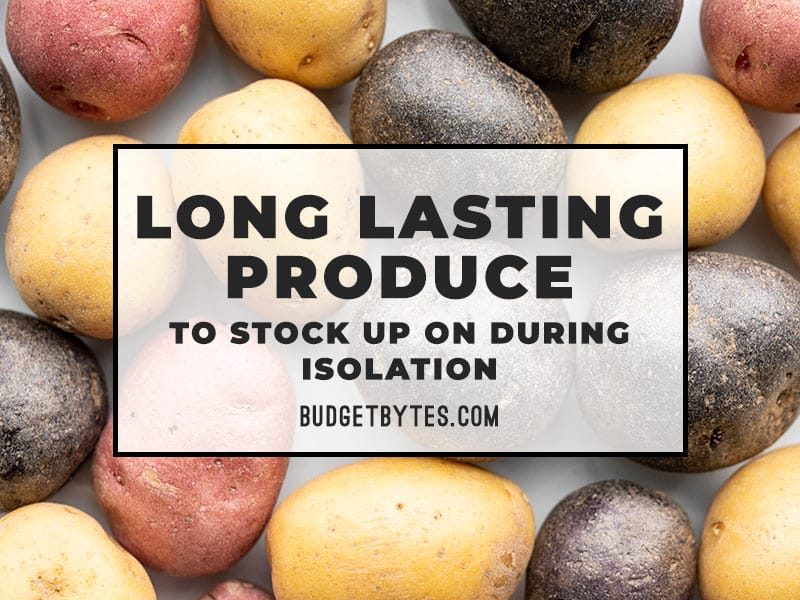
Stock Your Pantry and Freezer with These Fruit and Vegetables
This list is divided into three sections: fresh, frozen, and canned. Each section will include my favorite items, storage tips, and links to recipes where the ingredient can be used. The list is not all-inclusive, so if you have some favorites that aren’t listed below, feel free to share with the rest of us in the comments below!
Fresh Vegetables:
- Potatoes and Sweet Potatoes
- Store potatoes in a cool, dry, dark place with adequate air flow, away from onions, and they can last for a couple of weeks.
- Potatoes make easy and filling side dishes, like Garlic Herb Mashed Potatoes, Rosemary Roasted Potatoes, or Garlic Parmesan Oven Fries. They’re also great as part of a main dish, like Zuppa Toscana, Cheesy Cottage Pie, or Smoky Potato Chickpea Stew.
- Sweet potatoes are also extremely versatile and can be served as a main dish (Turkey Chili Smothered Sweet Potatoes), a side dish (Sweet Potato Fries), soup (Vegan West African Peanut Stew), baked goods (Sweet Potato Cornbread), and even breakfast (Sweet Potato Casserole Baked Oatmeal).
- Cabbage
- Store cabbage in a high humidity drawer in your refrigerator and it can last for months. If any of the outer leaves begin to wilt, simply remove them and use rest.
- Cabbage is a great low-carb replacement for noodles in dishes like Beef and Cabbage Stir Fry, it’s a great base for fresh slaws and salads, like Sweet Crunch Winter Salad or Classic Creamy Coleslaw, it makes a wonderfully filling addition to soup, like Beef and Cabbage Soup or “All You Can Eat” Cabbage Soup, and it can be used as a wonderful dose of fiber and flavor in pasta dishes, like Cold Peanut Noodle Salad, or Cajun Cabbage and Noodles.
- Onions
- Onions offer a wonderfully savory base note to many recipes and they last a long time at room temperature, so I usually buy them in bulk, 3-5 lbs. at a time. Keep your onions in a cool, dry, dark place away from potatoes.
- Use onions as the flavor base for soup (Homemade Chicken Noodle Soup) and beans (Slow Simmered Black Eyed Peas and Greens), roast them in the oven with peppers to top Bratwurst or make Fajitas. Add them fresh to salads like Honey Mustard Broccoli Salad, or Cowboy Caviar. And don’t forget, if you have leftover red onion, don’t let it go to waste! Make Pickled Red Onions to top salads, sandwiches, tacos, nachos, and more.
- Carrots
- Keep carrots refrigerated, in a high humidity drawer, and they should keep for weeks.
- Carrots make a great addition to soup, like Thai Coconut Curry Carrot Soup or Chunky Ham and Bean Soup. They’re wonderful when roasted in the oven (Roasted Carrot and Feta Salad or Curry Roasted Carrots), but they’re also great when shredded and added to salads, sandwiches, stir fries, and more (Sweet and Spicy Tuna Salad, Sesame Slaw, Savory Cabbage Pancakes).
- Winter Squash
- Winter squash, like spaghetti squash, acorn squash, butternut squash, and acorn squash (among others) are much harder than summer varieties, like zucchini and yellow squash. Because of their hard exterior, they last much longer at room temperature. Store your squash unrefrigerated, in a cool, dry place.
- Winter squash is great for roasting (Smoky Maple Roasted Acorn Squash), and then using as a base for salads and bowls (Chipotle Butternut Squash and Quinoa Salad).
- Celery
- When refrigerated as-is, celery can begin to soften within a week or so, but something magic happens when it’s wrapped in foil. Celery wrapped in foil and refrigerated can stay crisp for weeks!
- Grab some celery to use in soups (Chunky Lentil and Vegetable Soup), cut into sticks for snacks, or add to your salads (Crunchy Kale and Chicken Salad).
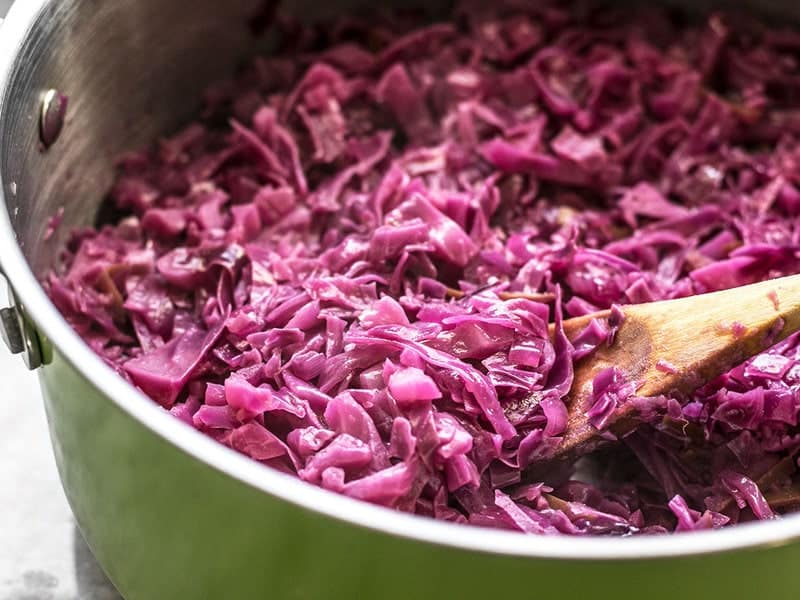
Fresh Fruit:
- Apples
- Refrigerated apples can last months.
- While fresh and crunchy, they’re my favorite for snacking as-is or with peanut butter, or adding to salads (Apple Dijon Kale Salad). Once they’re a little past their prime, they’re also great for cooking! Try them in Apple Spice Pork Chops, Nature’s Candy, or Braised Red Cabbage. They’re also great for desserts, like Slow Cooker Hot Buttered Apples.
- Oranges
- When refrigerated, oranges can last a couple of months (of course, this ultimately depends on their freshness when they were sold).
- In addition to being a tasty snack, oranges provide unique flavor to dishes like Slow Cooker Carnitas, Orange Chicken, or Cranberry Orange Scones.
- Pears
- Just like apples, pears make a great snack, a sweet addition to salads (Warm Pear and Brussels Sprouts Salad), baked goods, or your morning oatmeal.
- Grapefruit
- Just like oranges, grapefruit have a wonderfully long life in the refrigerator. They’re a versatile not-so-sweet fruit that allows them to pair effortlessly with both sweet and savory dishes.
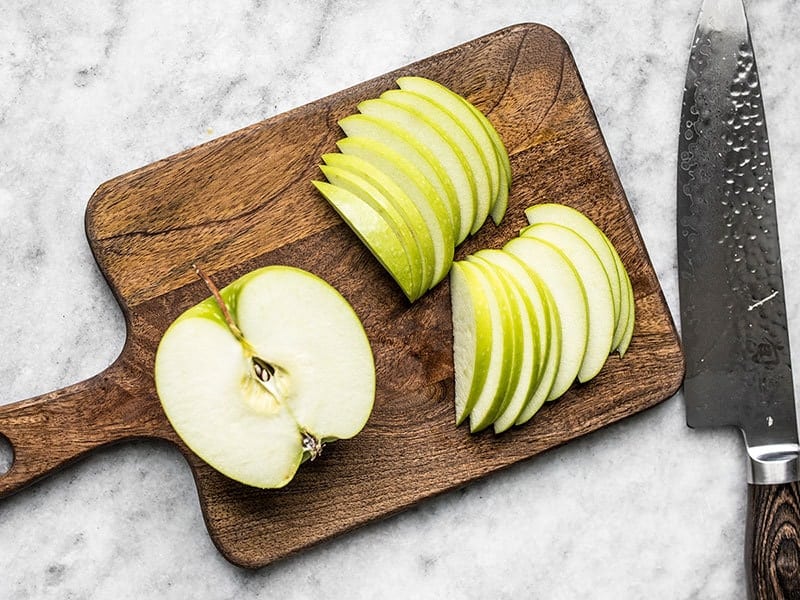
Frozen Vegetables:
I lean heavily on frozen vegetables all year long. Not only are they convenient (usually pre-washed and pre-chopped), but I don’t have to worry about using them before they go limp. I can use any amount that I need, and stash the leftovers in the freezer for later. Here are my favorite picks:
- Spinach – Fresh spinach goes bad so quickly, so I aways keep frozen on hand! It’s great to add to soups (Swamp Soup), to mix with cheese and stuff pasta (Pesto Stuffed Shells), or adding to egg dishes (Spinach Mushroom and Feta Crustless Quiche).
- Broccoli – Frozen broccoli florets are extremely versatile. I add them to pasta dishes (One Pot Bacon Broccoli Mac and Cheese), add them to stir fries (Simple Mushroom Broccoli Stir Fry Noodles), or just add seasoning and roast in a hot oven for an easy side dish (Oven Roasted Frozen Broccoli).
- Cauliflower – Just as with broccoli, frozen cauliflower is great for roasting in the oven, sautéing (Cauliflower and Chickpea Masala), or adding to soup (Moroccan Lentil and Vegetable Stew).
- Peas – Frozen peas are an easy way to add some green color, protein, and tons of fiber to any dish. Try them in soup (Vegan Winter Lentil Stew), pasta dishes (Creamy Tuna Pasta with Peas and Parmesan), and casseroles (Cheesy Cottage Pie).
- Corn – Frozen corn kernels are an easy way to add subtle sweetness and to inexpensively bulk up any recipe. I like to add them to burrito bowls, quesadillas (Hearty Black Bean Quesadillas), and salads (Cowboy Caviar).
- Green Beans – Frozen green beans are the next best thing to fresh. They maintain their color and texture quite well compared to canned green beans, and are easy to toss into soups (Vegetable Barley Soup), or steam up for an easy side dish.
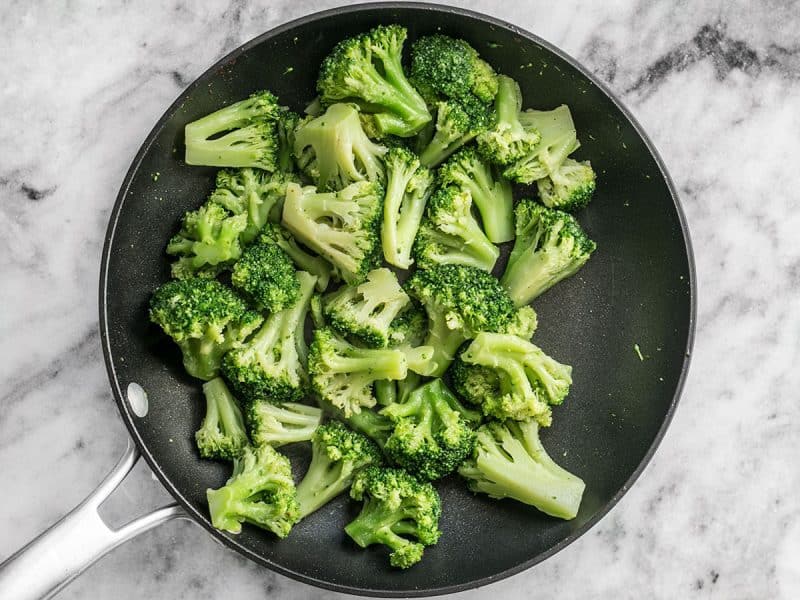
Frozen Fruit:
- Pineapple – Chopping fresh pineapple can be quite a task, so I like to buy it frozen (pre-chopped, yay!). Frozen pineapple can be added to stir fries (Sweet Chili Chicken Stir Fry Bowls), Smoothies (Pineapple Protein Smoothie), or even used to make salsa (Easy Pineapple Salsa).
- Melon – I like to eat frozen melon just as a snack (it’s like natural popsicle bites!), but it’s also great to thaw and add to a bowl of cottage cheese, or mix with feta and mint for a quick refreshing salad.
- Blueberries – Frozen blueberries are my favorite way to get a little dose of antioxidants. I add them to my oatmeal and yogurt on a regular basis (Blueberry Almond Overnight Oats), but they’re also great for baking (Blueberry Buttermilk Coffee Cake).
- Strawberries – Strawberries are great for adding to your homemade smoothie packs, adding to yogurt or oatmeal, or making a homemade frozen cocktail (Strawberry Rosé Slush). ;)
- Avocado – I’m seeing peeled and cubed frozen avocados more and more in the stores these days. While I haven’t tried them yet, I think they would make a great alternative when fresh are out of season and prices are sky high. Frozen avocado would be great for adding to smoothies, topping tacos, adding to salads, making guacamole, or filling enchiladas (Black Bean and Avocado Enchiladas).
- Mango – Mango is another fruit that can be kind of a pain to peel and chop, so frozen mangoes are super convenient. Frozen mangoes are great for smoothies, adding to stir fry (Mango Coconut Tofu Stir Fry Bowls), puréeing into sauces, or making mango salsas.
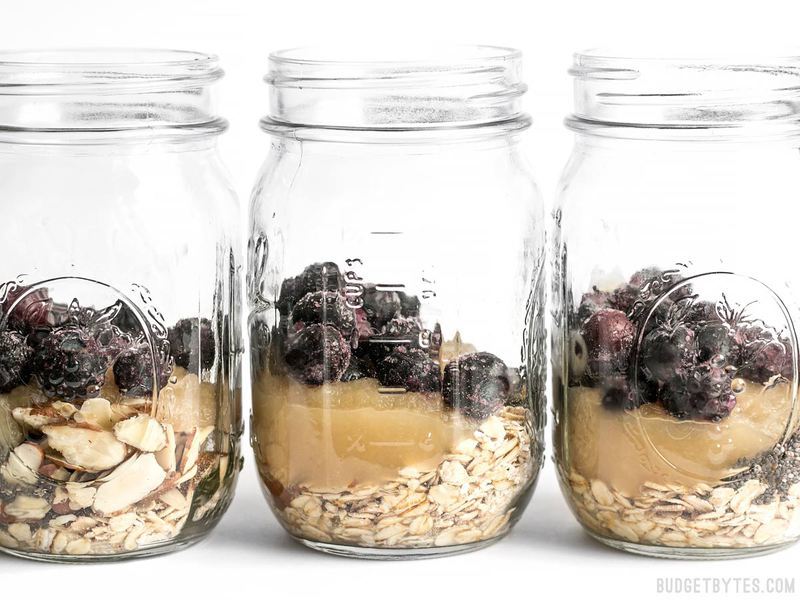
Canned Fruit and Vegetables:
While canned fruit and vegetables are my last resort option, I still consider them to be far better than no fruit or vegetables at all. Canned fruit and vegetables do sacrifice a little on the flavor and texture side in exchange for a nearly indefinite shelf life, which can be extremely valuable, especially in times like these.
For those worried about the nutritional content of canned fruits and vegetables, I’ve asked our consulting Registered Dietitian, Tori Watters, to weigh in on the subject. This is what Tori has to say:
“Although canned produce has a bad reputation, it can be an affordable, accessible, and convenient option. When shopping for canned vegetables, look for “no salt added” varieties. When shopping for canned fruits, look for those packed in 100% juice or water. Most canned goods can be drained and rinsed to further remove excess salt or sugar. When preparing meals for those with particular tastes and texture preferences, all servings of vegetables count in meeting micronutrient needs. Finally, as with any type of food, preparation is key; therefore, the fats, seasonings, and sugars you add to your produce can be even more important than how it is purchased!” – Tori Watters, RD
Here is a quick nutritional comparison of fresh, frozen, and canned items so you can see how they generally compare:
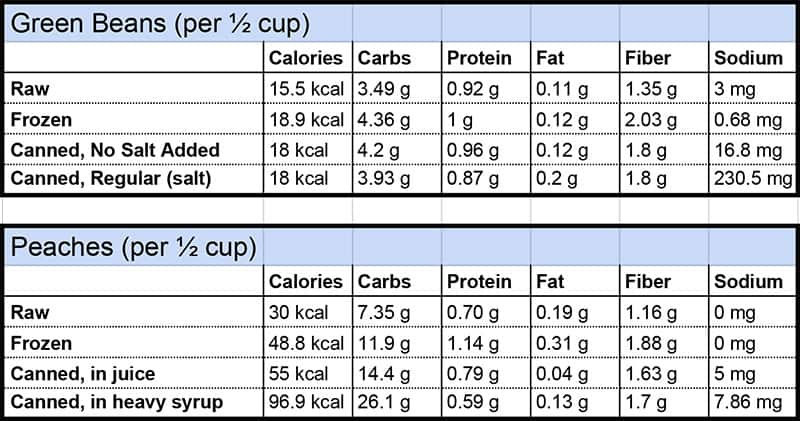
For more information on how and where we get our nutritional data, please visit our nutrition disclaimer.
Here are some of my favorite items to buy canned, even when supplies of other forms are not limited:
- Tomatoes (diced, crushed, paste, sauce)
- Artichoke Hearts
- Water Chestnuts
- Beets
- Olives
- Pineapple
What about you? What are your favorite long lasting fruits and vegetables, and your favorite ways to use them? Share yours in the comments below!


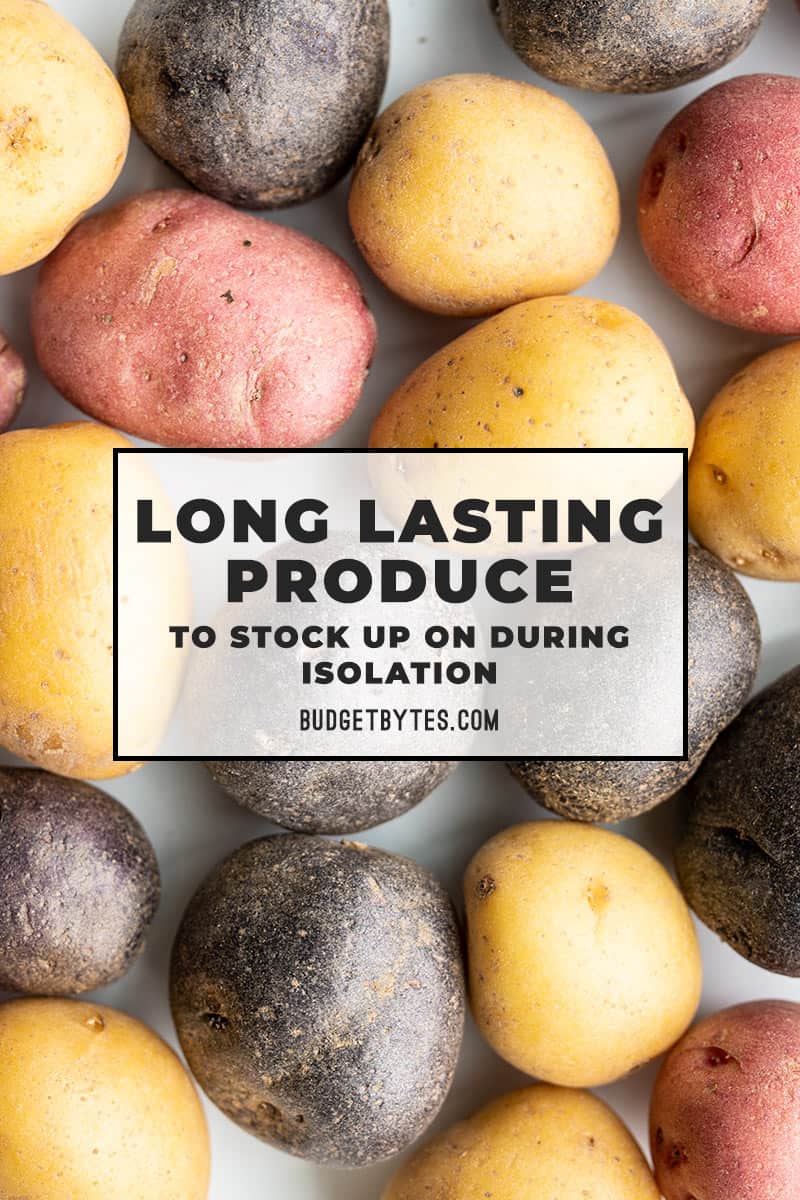
What secrets does Beth hold in her recipes that make them so delicious and budget-friendly? What inspired her to create such a wide range of dishes, from savory stews to sweet desserts? And most importantly, what is the story behind Beth’s passion for cooking and sharing her culinary creations with the world?”,
“refusal
Hi, Beth,
Thanks for all the work you do to maintain a very good site. I’m looking for “fresh” foods that can survive without refrigeration. These are the ones with which I have had the most success
About one week without refrigeration, maybe longer, definitely uncut and unbruised-
ROMA tomatoes
carrots
potatoes
onions
baby cucumbers
“live” lettuce (Still has rootball, kept in water)
apples
oranges
About 3 days or more
lettuce, cabbage, celery: Keep the bottom end in water.
The water might need to be changed
peaches
mangoes
Many berries last longer if given a “bath” in vinegar-water, then fully dried before stored in the refrigerator.
Pickles and olives can last a week, maybe longer, on the counter if they are completely under their brine. Hot conditions might make them deteriorate faster.
Sprouts are very nutritious and a great source of enzymes, as well as vitamins, etc. They can be surprisingly easy to grow. I like them anyway, but if I am eating mostly cooked food, I’m not getting enzymes. These are killed by high temperatures. Add sprouts to salads and sandwiches.
Excellent list! Thank you for sharing!
Hi Beth,
Natalie here from the UK.
Firstly, your posts and insights are soooo refreshing!!
I absolutely love tinned pears.. Very reasonably priced in the UK!
Best
Natalie
If your budget has more flex than your time, dried vegetables from North Bay Trading Company are awesome. I keep dried spinach, mushrooms, and onions in the pantry, and can always throw them into soup or spaghetti sauce. You’ll say, “I paid WHAT for a pound of spinach?” But when you’re still dipping into that same pound 18 months later and it still tastes like spinach, you’ll thank me. My favorite pantry meal is pasta with jarred spaghetti sauce enhanced with dried spinach/mushrooms/onions, garlic powder, oregano, basil, and frozen meatballs. (Note: I have no links or affiliation with North Bay. I just love their products.)
I need to try that out! I’ve never experimented with dried vegetables!
I made a homemade spice rub for ribs in a baggie. I put the ribs in the baggie and coated the ribs leaving a lot of the rub remaining. Can I save and reuse the rub at a later date?
TIA
Please do not do that. You will get sick. This article on marinades also applies to rubs: https://ask.usda.gov/s/article/Can-you-reuse-meat-marinade XOXO -Monti
Thanks for the update on produce.
I didn’t know a lot of this storage info; really useful, will save me £. I buy tinned sardines in tomato sauce in budget supermarkets. Cheap & nutritious. I eat on toast, in baked potatoes, pizza & even w pasta. Thnx for gt post.
Something I recently discovered is sprouting lentils! It is easy, crazy cheap, and gives you something fresh and growing. I like them in a grain bowl or on a salad, though my family prefers them in stir fry. My son, who is on a poor man’s PhD teaching salary, eats a ton of lentils already. He is back at university and called about sprouting them at school. They are pretty terrific.
I want to try that!!
You could buy tinned beets but fresh ones last a very long time too. I have a home on an island and we have very little access to fresh food there. I always stock up on loads of veg before I go and eat the more perishable ones first (lettuces, fresh herbs, cucumbers, zucchini, tomatoes). then go to the longer shelf life ones, then the frozen and canned. Then rice, beans, pasta.
I freeze wild blueberries in 2 lb containers (actually 1 kg as I am in Canada) and then use them in my Buckwheat pancakes:
2 and 2/3 cups milk with large egg and 2 teaspoons of REAL Vanilla extract (I actually use/make my own from vanilla bean pods in 1 oz of good dark navy rum for a year) and three table spoons of canola oil, that all gets beaten together then added to a well mixed 2 cups of white flour with 2/3rd cup of buckwheat, 2 tablespoons of cinnamon sugar and 4 teaspoons of baking powder. Once all mixed and smooth, I add 2 cups of my Frozen blueberries to make a great set of buckwheat pancakes. I tried varying amounts of other wheat and they didn’t work out but if I used 2 and 1/4 cups of Gluten Free Flour, they were fine. We have a daughter in law who is Celiac. Add my son and we have to double the ingredients. Now add some fine butter and real maple syrup, some orange juice, hot coffee and a sunny morning….ah life can be so good.
Love this article! Is there any way you can make the hyperlinks on the downloadable PDF link back to the recipes on your website?
Hi Melissa! Thanks! Can you shoot me an email at [email protected] and let me know which pdf you’re referring to?
Some excellent tips. We are in isolation in the UK and I stocked up with lots of dried goods to get us through. I have been experimenting with lots of dishes made with pulses and rice- about 6 different versions of lentil dahl so far! We have also started growing our own fruit and vegetables. We had been talking about doing this for a while, but the COVID-19 situation has given us a push in that direction.
Another trick for celery that I recently learned – even when it gets soft and droopy, it can be revived by cutting off the end and sticking the stalks in a glass with a few inches of water! I use reusable mesh produce bags, so my celery was getting droopy and sad FAST with so much more exposure to air/gas in the crisper. But i put it in water and it hardened back up and gave me another week to eat it!
I really appreciate this post. Yet another reason I love your site.
My mom buys a bunch of avocados when they go on sale and cuts and freezes them herself. Not sure quite how the texture changes, but she’s usually adding it to something or using it as a spread, so it’s not as big of an issue!
Re celery in foil suggestion:
I wrap celery hearts in paper towel then roll it in foil wrap and put in fridge,
Leave both ends open and it lasts a few weeks.
If celery stalk are cut, put them in a container with cold water and they will stay crispy.
Change water regularly.
The refrigerated cold water container will also crisp wilted stalks.
Works for limpy carrots as well.
I have also had the water bath work for very limp broccolini.
Canned goods are pretty much gone for me! But fresh produce is in abundance! I get as much spinach as I can because my local grocery stores keeps restocking it — so I’ll take it!
I haven’t been buying much animal protein at all, aside from milk, eggs, yogurt and cottage cheese so I’ve been relying on beans and tofu/soy as my main go-to out of necessity.
Thanks for these tips!
In my area, I’m having the opposite problem — many fresh fruits and vegetables are plentiful, while pantry items are totally wiped out, and meat and poultry are almost as hard to come by. So my challenges are finding creative ways to make my fresh produce stretch — because I’m uncomfortable going out more than once every two weeks — while learning to rely less on animal protein. Thank you to the BudgetBytes team and community for continuing to share great ideas! Stay healthy and safe.
This is extremely helpful. Thank you!
You can chop and freeze onions or green onions in ziploc bags. You can blanch and freeze chopped carrots .You can chop and freeze celery and bell pepper. You can chop,blanch and freeze zucchini, yellow squash, cauliflower, broccoli. You can freeze whole unpeeled tomatoes to use for cooking. You can chop cilantro into ice cube trays with a little water and freeze. Better if used in cooked foods, but you can use it in salsa. Chop and cook kale for use in soups. Yogurt can be frozen for use in smoothies or baking, you can freeze butter and cream cheese, shredded cheese too. You can freeze milk if you pour a little of it off into another jar to allow for expansion.You can freeze grapes for a great frozen snack. I’m trying to only shop once a month now. Stay safe my friends.
Sending many thanks and well wishes. I greatly appreciate the information. Please remain safe and again, thank you for many questions answered.
Beth, as always, I treasure this place and the care you take for your readers. Vegetables like parsley, celery and green onions, I’ve had success with “planting” in a jar in the fridge – trim the bottoms, just enough water to cover, and cover all with a plastic bag. They will last for a couple of weeks! And thank goodness we have electricity, so a freezer and can store perishables there at least until storm season. (I never remember what name I’ve posted under, though, so just know that Amy in Gretna, LA has followed you all this time and appreciates all you do for us!)
*By plastic bag, I mean a Ziploc-type bag as opposed to a grocery-store-type bag :)
It’s a great time to grow sprouts, too! My mung beans will be ready in just a day or two for some great stirfry. I’m waitinf for other sprouting seeds that I ordered online since local sources were out.
came across your site yesterday and have passed your site on to my daughter.
thank you for creating .
You’re welcome! Shoot us an email at [email protected] and we can get that recipe for you!
Some grocery stores sell frozen vegetable ‘starter mixes’ — I always have a few bags of frozen diced onions and frozen, cut pepper mixes. The pepper mixes are excellent for chili or stir fry, and the frozen chopped onions are great if you don’t use a LOT of onion, but like to add a bit to many things.
The fact that they’re frozen means they last forever and don’t get away from me if I change up my meal plans.
Thanks so much for this. I really appreciate your great ideas and positive attitude during this time. I make your recipes almost every day :)
If you buy unripe avocados, you can store them in the fridge for weeks. Take one out when you want to let it ripen (I put mine in the fruit bowl with the apples) and voila, fresh avocado in a few days.
If you store fresh mushrooms in a paper bag in the fridge, as they age, they will dry up instead of molding – you can still use them, they’re just half-dried. (Dried mushrooms are another shelf stable item I keep around.)
Also, I have better luck storing my onions in the fridge.
I, too, am going to try wrapping my celery in aluminum foil. A great tip, Beth.
Turnips keep well although not as well as rutabagas.
Parsley keeps two-three weeks if I rinse and dry it well and store it in a well-sealed container (such as old glass pickle jar or a Tupperware container.
My onions and potatoes have been happily coexisting for many decades. I’m wondering why you say to keep them apart.
Thanks for all the recipes and inspiration! You are a huge influence on our culinary habits. Often my husband, when he likes something, will ask, “Is this a budget bytes recipe?”.
Onions give off a lot of ethylene gas, which can cause potatoes to spoil faster and potatoes let off a lot of moisture, which can cause the onions to spoil faster. :)
Reorganizing fridge, are there any other vegetables that should not be mixed with onions? Onions and garlic? Based on info to increase longevity, store cabbage, carrots, garlic and celery together? Then potatoes, sweet potatoes and squashes together?
All fruits together, i.e. apples, citrus, mangoes, dragon fruit, papaya, etc?
Home is very high humidity so all fresh is placed in refrigerator.
Again, thank you and many blessings.
My local grocery has been out of frozen and canned veg but had plenty of fresh so I’ve blanched and frozen broccoli, kale, chard and green beans.
Canned baby corn is awesome in stir-fries, pasta salad, and ramen. I also really like to freeze fresh vegetables in different combos for use in soups later. I usually do the celery-carror-onion standby, but also peppers and onions, and onion, celery and zucchini for making pasta e fagioli.
My grocer has been out of frozen too! I bought extra fresh produce then diced and froze my own bell peppers and onions, sliced limes and quartered lemons, blanched and froze broccoli and carrots too.
Wrap Celery in foil! What the What!!!!?!?! That is awesome!!
Beth, your tips on food storage and meal planning are super useful at the best of times, and and these days I’m finding them absolutely invaluable! Thanks for getting us through the tough times:)
Rutabagas last a long time, too!
I find that broccoli is a champ in a plastic bag in my crisper drawer. I can usually keep it on hand for at least a week, sometimes two weeks with no trouble.
I also wrap a head of romaine in cloth and place it in a plastic bag, and it too, will keep for a week or two, sometimes longer in the crisper drawer. I hate using the plastic bags, but they actually help keep my produce fresh for longer compared to just sitting in the drawer.
These are great! I’d like to add (and I think you taught me this) that when some of these veg are on their way out, you can freeze them. I chop up carrots and celery to freeze for future soups or put spinach in an airtight freezer bag for soups and smoothies. I picked up fresh green beans from Aldi a week ago because they were so low on frozen veg, but they are starting to look a little limp. Time to chop those up and put them in the freezer, too. :-)
Beth you are awesome. I was coming home from an extended trip to Central America when I got your pantry staples list. I was unprepared for the chaos I encountered when entering the US on March 12 so I printed the list and went to the store to grab those staples and whatever fresh fruit and veg I could find. I’ve been stuck at home since ordering online which is getting harder and harder – nobody handpicks the fruit and veg like I do myself, and so much got damaged in the delivery process. I’m going to focus on your recommendations here for now
.
Yesterday I joined a CSA and am looking for farm fresh veg, fruit and eggs from Late April through Thanksgiving. Love your recipes and have been recommending your site to all of my. out of work friends.
Thank you!! This is a great list and I am really excited to make some dishes that you linked!
I often take whatever’s left in my bag of fresh spinach and put it in the freezer for use in smoothies. Blends up just fine!
Also, I can’t believe you didn’t post the pineapple salsa recipe with mention of canned pineapple! When my son was two and sooooo picky, we’d make your coconut rice, seasoned black beans, and pineapple salsa. He’d have eaten it breakfast lunch and dinner!
https://vitalityholisticwellnessguide.com/coconut-rice-take-2/
https://vitalityholisticwellnessguide.com/quick-seasoned-black-beans/
https://vitalityholisticwellnessguide.com/easy-pineapple-salsa/
Absolutely useful, money and time saver ! Thank you so much !
I have started sprouting my own microgreens. I ordered some organic seeds from a reputable sprouting seed company,and I just soak them in water for a few hours in a jar then drain them. I rinse them twice a day, carefully removing hulls. In 4 days I have a jar full of green, crunchy sprouts to put on sandwiches and salads. There is always a danger of foodborne illness with sprouts, but if you keep everything scrupulously clean, you will have fresh sprouted microgreens to enjoy during this time of scarcity. Also, plant a couple of pots of herbs or a cherry tomato for some variety in your meals.
Thank you for this! I like to buy bananas, chop them, and freeze them to make “nice cream” in the food processor.
I’ve never seen the foil tip for celery, I will definitely be trying that. Thanks!
Everything I’ve read about frozen avos says the texture is terrible; they are excellent for smoothies or for being an ingredient (say in brownies), but for anything where the avos themselves are a feature ingredient will not be good
One other thing to note: you’re not limited by what your grocery store carries for frozen vegetables or fruit. My local Aldi doesn’t carry frozen bell peppers and the fresh ones are sold in 3 packs, which can make it hard to get through them all. So, I chop them all up and freeze in 1 cup portions to use in cooking. I do the same with excess celery, cooking greens like spinach and kale, zucchini, green onions, leeks, and tomatoes (anything that I will cook with). Plus, if I have extras, I’ll freeze
all sorts of fruits (for smoothies, baked goods, etc), including citrus, for juicing.
I do this same too. I’ll often bag 1/2 lb chopped carrots with 1/2 lb chopped celery and freeze it for a quick add to the Budget Bytes slow cooker black bean soup.
This is a great list, just what I needed. Thanks!